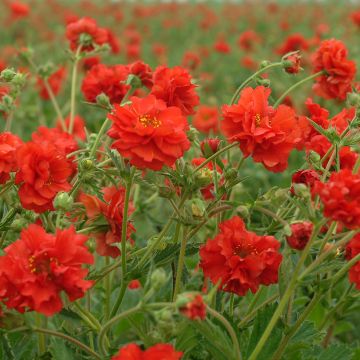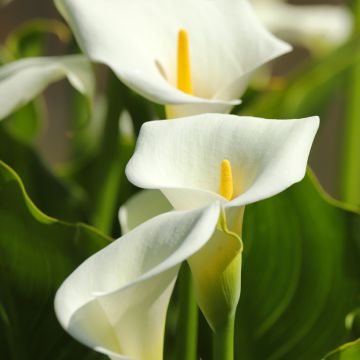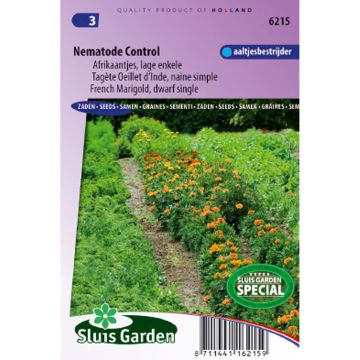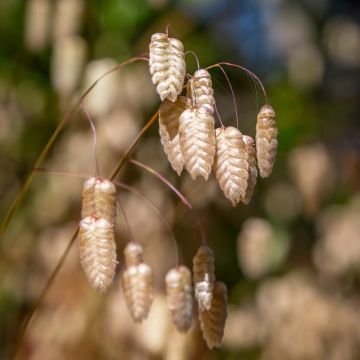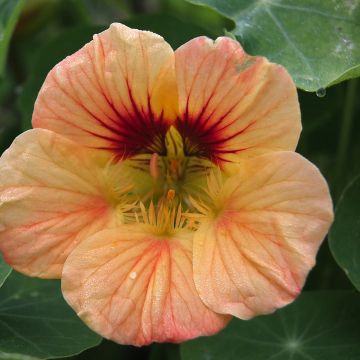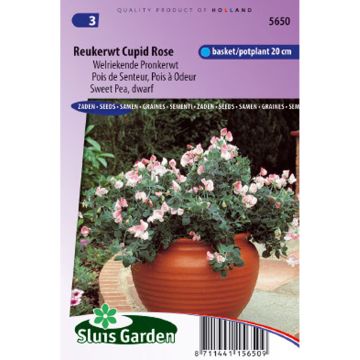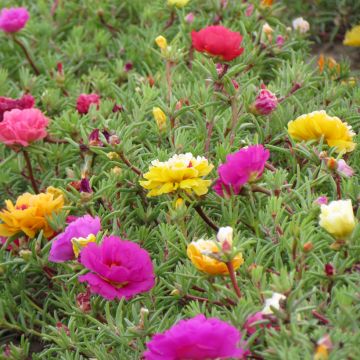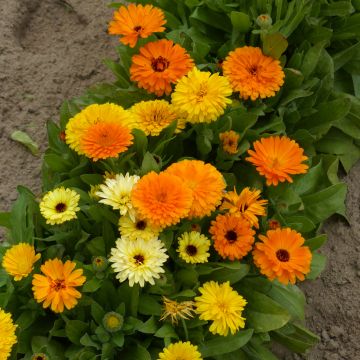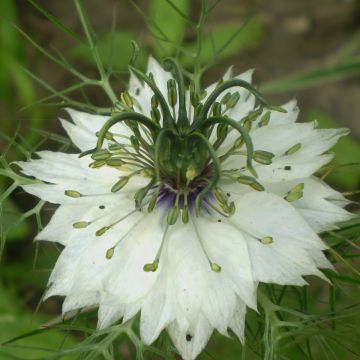

Tree Peony Rockii mixed
Paeonia suffruticosa Rockii Mixed
Paeonia suffruticosa Rockii Mixed
Tree Peony, Chinese Tree Peony
It was only after opening the packet of seeds that I learned that it might take 5 years to see them bloom!!! Isn't that a bit of a joke on us, really???
Régine, 21/04/2018
This plant carries a 6 months recovery warranty
More information
We guarantee the quality of our plants for a full growing cycle, and will replace at our expense any plant that fails to recover under normal climatic and planting conditions.
Seed-only orders are dispatched by sealed envelope. The delivery charge for seed-only orders is €3.90.
Does this plant fit my garden?
Set up your Plantfit profile →
Description
Paeonia 'Rockii Mixed' is a highly sought-after peony bearing large flowers composed of tissue paper petals, sometimes speckled with dark burgundy at their bases. It is incredibly generous and breathtakingly beautiful!
If peonies are so appreciated in our gardens, it is because of their opulence, longevity and robustness. Like the genus, the 'Rockii Mixed' variety displays a remarkable flowering from April to May, with flowers measuring up to 25 cm (10in) in diameter. White, yellow, salmon, light pink, and dark pink are offered here.
Originating from China and belonging to the Paeoniaceae family, the bush peony distinguishes itself from herbaceous peonies, which disappear in winter, by the woody nature of its stems. It is a hardy bush, at least down to -15°C (5°F), reaching a height of 1.5 metres (5 feet) at maturity.
The peony thrives in regions with distinct winters, as the cold stimulates the formation of its buds but dislikes spring frost that can damage them. Therefore, you should plant it in a sheltered spot, away from the wind, in full light or partial shade. Its generosity is also due to its appetite, at least during the first few years. We recommend regular additions of well-rotted compost and mulching around its base.
In the garden, the peony is ideal for a romantic flower bed alongside hardy geraniums, catmints, and roses. It is also charming and holds up well in bouquets.
Growing a peony from seed is not complicated, but it is slow and involves several stages. Your patience will be rewarded after 5 to 7 years with the appearance of the first flowers.
Report an error about the product description
Flowering
Foliage
Plant habit
Botanical data
Paeonia
suffruticosa
Rockii Mixed
Paeoniaceae
Tree Peony, Chinese Tree Peony
Cultivar or hybrid
Other Thompson and Morgan seeds
Planting and care
The germination of peony seeds can be slow and irregular, but your perseverance will be rewarded.
Upon receiving your Paeonia 'Rockii Mixed' seeds, place them in a plastic bag (such as a freezer) containing slightly damp sand or vermiculite. Seal the bag and place it in a location protected from direct sunlight, in a warm area around 21°C (69.8°F). For three months, the root system of your Peony will begin to develop. Once it reaches a length of 2.5 cm (1in), move your bags to a much cooler location, around 5°C (41°F), for 10 to 12 weeks.
Regularly monitor the development of your plants: as soon as the shoots appear, remove them from the bag and transfer them to pots. The growth should occur in a cool location until your plant is well established. Gradually acclimate it to the conditions of the garden.
Sowing period
Intended location
-
, onOrder confirmed
Reply from on Promesse de fleurs
Flower seeds
Haven't found what you were looking for?
Hardiness is the lowest winter temperature a plant can endure without suffering serious damage or even dying. However, hardiness is affected by location (a sheltered area, such as a patio), protection (winter cover) and soil type (hardiness is improved by well-drained soil).

Photo Sharing Terms & Conditions
In order to encourage gardeners to interact and share their experiences, Promesse de fleurs offers various media enabling content to be uploaded onto its Site - in particular via the ‘Photo sharing’ module.
The User agrees to refrain from:
- Posting any content that is illegal, prejudicial, insulting, racist, inciteful to hatred, revisionist, contrary to public decency, that infringes on privacy or on the privacy rights of third parties, in particular the publicity rights of persons and goods, intellectual property rights, or the right to privacy.
- Submitting content on behalf of a third party;
- Impersonate the identity of a third party and/or publish any personal information about a third party;
In general, the User undertakes to refrain from any unethical behaviour.
All Content (in particular text, comments, files, images, photos, videos, creative works, etc.), which may be subject to property or intellectual property rights, image or other private rights, shall remain the property of the User, subject to the limited rights granted by the terms of the licence granted by Promesse de fleurs as stated below. Users are at liberty to publish or not to publish such Content on the Site, notably via the ‘Photo Sharing’ facility, and accept that this Content shall be made public and freely accessible, notably on the Internet.
Users further acknowledge, undertake to have ,and guarantee that they hold all necessary rights and permissions to publish such material on the Site, in particular with regard to the legislation in force pertaining to any privacy, property, intellectual property, image, or contractual rights, or rights of any other nature. By publishing such Content on the Site, Users acknowledge accepting full liability as publishers of the Content within the meaning of the law, and grant Promesse de fleurs, free of charge, an inclusive, worldwide licence for the said Content for the entire duration of its publication, including all reproduction, representation, up/downloading, displaying, performing, transmission, and storage rights.
Users also grant permission for their name to be linked to the Content and accept that this link may not always be made available.
By engaging in posting material, Users consent to their Content becoming automatically accessible on the Internet, in particular on other sites and/or blogs and/or web pages of the Promesse de fleurs site, including in particular social pages and the Promesse de fleurs catalogue.
Users may secure the removal of entrusted content free of charge by issuing a simple request via our contact form.
The flowering period indicated on our website applies to countries and regions located in USDA zone 8 (France, the United Kingdom, Ireland, the Netherlands, etc.)
It will vary according to where you live:
- In zones 9 to 10 (Italy, Spain, Greece, etc.), flowering will occur about 2 to 4 weeks earlier.
- In zones 6 to 7 (Germany, Poland, Slovenia, and lower mountainous regions), flowering will be delayed by 2 to 3 weeks.
- In zone 5 (Central Europe, Scandinavia), blooming will be delayed by 3 to 5 weeks.
In temperate climates, pruning of spring-flowering shrubs (forsythia, spireas, etc.) should be done just after flowering.
Pruning of summer-flowering shrubs (Indian Lilac, Perovskia, etc.) can be done in winter or spring.
In cold regions as well as with frost-sensitive plants, avoid pruning too early when severe frosts may still occur.
The planting period indicated on our website applies to countries and regions located in USDA zone 8 (France, United Kingdom, Ireland, Netherlands).
It will vary according to where you live:
- In Mediterranean zones (Marseille, Madrid, Milan, etc.), autumn and winter are the best planting periods.
- In continental zones (Strasbourg, Munich, Vienna, etc.), delay planting by 2 to 3 weeks in spring and bring it forward by 2 to 4 weeks in autumn.
- In mountainous regions (the Alps, Pyrenees, Carpathians, etc.), it is best to plant in late spring (May-June) or late summer (August-September).
The harvesting period indicated on our website applies to countries and regions in USDA zone 8 (France, England, Ireland, the Netherlands).
In colder areas (Scandinavia, Poland, Austria...) fruit and vegetable harvests are likely to be delayed by 3-4 weeks.
In warmer areas (Italy, Spain, Greece, etc.), harvesting will probably take place earlier, depending on weather conditions.
The sowing periods indicated on our website apply to countries and regions within USDA Zone 8 (France, UK, Ireland, Netherlands).
In colder areas (Scandinavia, Poland, Austria...), delay any outdoor sowing by 3-4 weeks, or sow under glass.
In warmer climes (Italy, Spain, Greece, etc.), bring outdoor sowing forward by a few weeks.








































